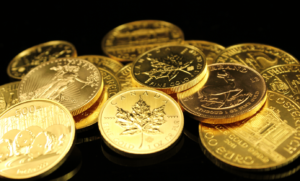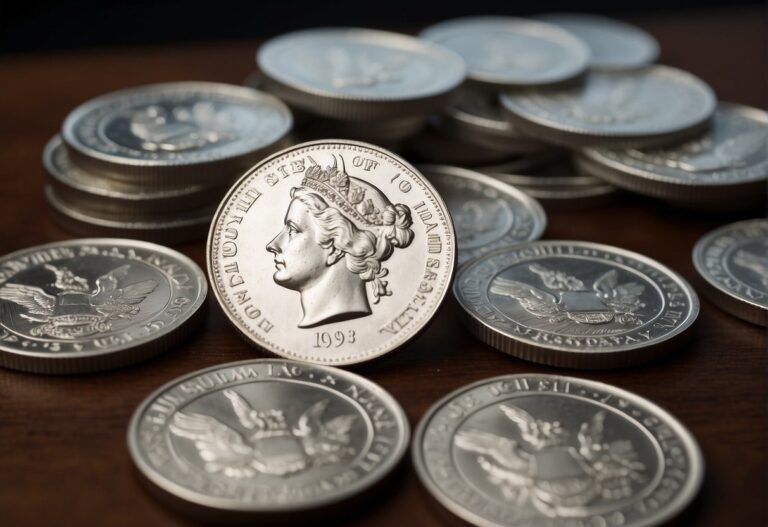A gold quarter’s worth is a mixture of collectability, historical value, and gold content. Gold quarters come in various types, including actual gold coins and gold-plated commemorative items. The gold quarter’s value ranges significantly – genuine gold quarters like the Standing Liberty Centennial Gold quarter command a high price due to their gold content and collector interest. In contrast, gold-plated quarters hold a nominal value over their face value.

The price history of gold quarters is influenced by their rarity, condition, and the market price of gold. Collectors may pay a premium for quarters with historical significance or those in exceptional condition. Economic factors also sway the value of gold coins, as investors often view gold as a hedge against inflation.
Knowing the market and the specific features that affect coin value play critical roles in determining what a gold quarter is worth.

Get Matched With A Vetted
GOLD IRA ADVISOR TODAY
How Much Is A Gold Quarter Worth? Key Takeaways
- The value of gold quarters differs based on whether they are solid gold coins or gold-plated.
- Historical significance, rarity, and gold market prices are significant determinants of a gold quarter’s worth.
- Economic conditions can influence the investment appeal and value of gold quarters.
Understanding Gold Quarters

Gold quarters have intrigued collectors and investors alike, with their value contingent upon factors such as type, gold content, purity, and whether they are officially sanctioned products of the U.S. Mint.
Types of Gold Quarters
There are two primary categories: genuine gold quarters and gold-plated quarters. Genuine gold quarters, like the Standing Liberty Centennial Gold Coin, are issued by the U.S. Mint, celebrating historical designs in 24-karat gold. These are official releases and carry significant value among collectors. On the other hand, gold-plated quarters are regular circulation coins with a thin layer of gold applied to their surface. They are often sold as novelties or collectibles but hold minimal intrinsic value compared to their fully gold counterparts.
Gold Content and Purity
The intrinsic value of a gold quarter is primarily determined by its gold content and purity. Genuine gold quarters typically comprise 24-karat gold, which denotes a purity of 99.99%. For example, a genuine gold quarter may contain approximately 0.25 troy ounces of pure gold.
When assessing the value of these coins, the current gold spot price is a crucial factor, as it fluctuates regularly, influencing the quarter’s market value.
Historical Value and Price History

The value of gold quarters has varied significantly over time, influenced primarily by the price of gold and the coin’s rarity and condition. This section explores the nuances of historical coins and the overall trends in gold prices, providing insight into their past economic worth.
Significant Historical Gold Quarter Coins
The 1796 Turban Head gold $2.50 Quarter Eagle is one of the first gold coins minted by the United States. Its scarcity and age make it exceptionally valuable. Similarly, the 1808 Capped Bust gold $2.50 Quarter Eagle stands out for its rarity due to the limited mintage, enhancing its historical worth. Collectors cherish these coins not just for their gold content but also for their deep historical significance and rarity.
Gold Price Fluctuations
Historically, the price of gold has undergone significant fluctuations, reflecting economic conditions, inflation rates, and global events. The chart of gold prices over the last century shows a long-term growth pattern with intermittent periods of volatility. For instance, a century-long data visualization indicates that accurate gold prices (adjusted for inflation) have oscillated dramatically, underscoring the unpredictable nature of commodity markets.
Determining the Value of a Gold Quarter

Evaluating a gold quarter involves meticulous attention to prevailing gold prices and the coin’s attributes, such as its condition and scarcity. These factors combine to create a composite defining the quarter’s worth in the collectors’ market.
Market Price Factors
The market price of a gold quarter is greatly influenced by the spot price, which is the current market rate for immediate delivery of gold. This spot price fluctuates based on economic variables, supply and demand, and geopolitical events. For instance, a U.S.-minted gold quarter containing 0.25 ounces of gold is directly pegged to this rate. However, it’s important to remember that the melt value — the value of the coin if melted down for its constituent precious metal — often differs from the coin’s numismatic or collector’s value.
Gold Plated Quarter Condition and Rarity
The condition of a gold quarter is a pivotal aspect of its valuation, with higher grades like MS-66/67 indicating fewer blemishes and fetching higher prices. A coin’s rarity also plays a significant role; for example, a Standing Liberty Centennial Gold Coin is particularly valuable, given its limited release. Additionally, face value is only a legal tender value and does not reflect the actual market price of the coin, especially if it is a rare or limited-edition issue.
Selling Gold Quarters

When an individual decides to sell gold quarters, it is crucial to understand both the methods of sale and the risks of encountering counterfeits. There are reliable avenues to navigate and precautions to ensure authenticity and receive a fair price.
How to Sell Gold Quarters
One should begin by determining the gold quarter’s value, which its condition and rarity can influence. A gold quarter’s condition is often assessed by a grade given by reputable grading services. Selling to a reputable dealer is preferred, as they offer expertise and a transparent evaluation. Individuals may choose to sell through:
- Auctions: Online or in-person can attract collectors willing to pay a premium for rare items.
- Coin shops: Local coin shops offer the convenience of direct evaluation, but prices may vary based on shop policies.
- Online marketplaces: Websites dedicated to coin sales can reach a wider audience but may involve fees or shipping concerns.
All routes should involve obtaining multiple offers to ensure the best possible price.
Avoiding Counterfeit Gold Plated Quarters
Counterfeits can significantly affect the gold quarter’s value. Sellers must be vigilant by verifying their coin’s authenticity before the sale. Important steps include:
- Documentation: Possession of original packaging and certificates of authenticity from the mint can support a coin’s legitimacy.
- Verification: Expert assessment from third-party grading services can attest to the coin’s authenticity and condition.
- Research: Understanding common signs of counterfeits helps sellers identify discrepancies in their coins.
Conducting transactions with respected dealers or auction houses known for their diligence in avoiding counterfeit coins is advisable.
Investment Potential

Investing in gold quarters can provide a stable asset for investment portfolios, often sought after for their historical value and potential to hedge against inflation.
Gold Quarters in Investment Portfolios
Gold quarters can enhance an investment portfolio by adding diversity and mitigating risk. Unlike equities and bonds, gold often maintains its value during economic uncertainty. For collectors and investment portfolios, including rare, mint-condition gold quarters, such as those with the certificate MS-66/67, can lead to meaningful profits.
History shows that high-quality gold quarters, like the U.S.-minted ones containing 0.25 ounces of pure gold, have been valued at $512.00 in the collectors’ aftermarket.
It’s also worth mentioning that certain retirement accounts, like a gold IRA (Individual Retirement Account), allow gold quarters and other precious metals to be held in these accounts, potentially enhancing long-term investment returns. However, it’s essential to consider that the value of these coins can be volatile and influenced by numerous factors, including collector demand and market conditions.
Market Trends and Gold Investments
The value of gold quarters is subject to the whims of the market, where investment in gold reflects current market trends. For instance, the Standing Liberty Centennial Gold Coin, minted in 2016, has seen its market value rise to $834.42, indicating a positive trend for similar high-quality gold quarters.
Investors need to monitor these market trends to make informed decisions since the investment potential of gold quarters is closely tied to fluctuations in the gold market.
Investors must also remember that gold-plated quarters, which carry a limited amount of gold, are generally valued only at their face value of $0.25. Still, genuine gold coins can make profitable investment pieces, especially when considered alongside historical gold price movements.
The investment decision should always be based on thorough research and an understanding of current and historical market data.
Gold Plated Quarter Collectability

Collectors value gold quarters for their rarity, historical significance, and artistic designs. These coins are not just currency but also cherished as miniature works of art and history.
Rare and Special Edition Gold Quarters
Rare gold quarters, such as the 1808 Capped Bust Gold $2.50 Quarter Eagle, are significant for their scarcity and historical value. For instance, this particular coin—minted in a minimal quantity of only 2,710—is prized for its worth far beyond its face value, as indicated by a striking value of $2,350,000.
Special editions like the Standing Liberty Centennial Gold Coin from 2016, struck in a higher gold purity, are currently valued at over 0, demonstrating the potential investment and collectible interest in these coins.
Gold Quarter Grading and Appraisal
The condition of collectible coins is often assessed by professional grading services such as PCGS (Professional Coin Grading Service) and NGC (Numismatic Guaranty Corporation). A gold quarter’s grade can immensely affect its value; for instance, a grade of MS-66/67 indicates a sharp strike and full original luster with minimal contact marks, significantly increasing the coin’s collectors’ aftermarket worth.
Appraisers rely on this grading to evaluate coins accurately, ensuring collectors understand the quality and value of their gold quarters. Collectors need to seek appraisals from reputable sources to ascertain the precise market value of their rare coins.
Impact of Economic Factors

The value of a gold quarter is notably influenced by economic events, particularly inflation and recession, which cause fluctuations in purchasing power and investment behavior.
Inflation and Recession Effects
In periods of high inflation, currency’s purchasing power diminishes, often leading investors to buy gold as a store of value. A rise in inflation tends to increase the price of gold as it is seen as a hedge against the depreciating value of fiat currencies. Conversely, during recessions, the demand for gold can increase due to its reputation for retaining value, which may drive up its value even though typical consumer spending is down.
Gold as a Hedge Against Market Volatility
Gold has historically been viewed as a safe-haven asset during market volatility and instability. Investors often seek gold to protect their wealth against unpredictable stock market movements and currency fluctuations. This perception significantly upholds gold’s worth, bolstering its price in the collectors’ aftermarket when economic forecasts predict turbulent times.
Legality and Regulation

In assessing the value of gold quarters, it’s essential to understand the legal framework governing U.S. currency production and modification. Two significant aspects in this context are the general U.S. currency law and the historical Coinage Act of 1792.
U.S. Currency Law
U.S. currency laws establish the legal basis for what constitutes legitimate currency and coin production. The U.S. government strictly regulates the minting and distribution of currency, ensuring that only government-issued coins carry legal tender status. It is unlawful for private mints to produce coinage that resembles official U.S. currency too closely.
Coinage Act of 1792
The Coinage Act of 1792 set forth the standards for coinage by the U.S. Mint, including the specification of denominations and the assurance of their uniformity. This historic act laid the groundwork for regulating U.S. coins’ purity, weight, and value and established the dollar as the standard unit of money in the United States.
Buying Gold Quarters

Investing in gold quarters is a severe business that mandates a careful selection of sellers and products. When considering the purchase of these valuable collectibles, it’s essential to focus on both the authenticity and the potential investment returns.
Purchasing Gold Quarters from Reputable Sources
They should prioritize buying gold quarters from reputable dealerships. Doing so ensures authenticity and fair pricing. A history of reliable transactions, positive client feedback, and transparent business practices characterize reputable dealerships.
They may also provide certificates of authenticity for their gold quarters, adding an extra layer of security for buyers. Dealers like American Hartford Gold often maintain a selection of high-quality coins and can advise on the nuances of gold quarter investment.
Gold IRA Companies
Gold IRA companies provide a unique opportunity for those interested in blending collectibles with retirement planning. Companies like Goldco and Augusta Precious Metals have earned a reputation for facilitating precious metals IRAs. They allow individuals to add gold quarters to their retirement portfolios, providing a long-term investment that potentially hedges against inflation. When selecting a gold IRA company, it must comply with IRS regulations to maintain the tax advantages associated with retirement accounts.
Physical Characteristics and Identification

The value of a gold quarter is closely tied to its physical attributes. A collector can establish the coin’s authenticity and quality by examining its weight and size and identifying marks.
Gold Quarter Weight and Size
A real gold quarter should weigh precisely 0.25 troy ounces. In terms of size, these coins usually maintain a standardized dimension consistent with other quarters. Still, the thickness can vary depending on the specific issue and its gold content.
Identifying Marks and Hallmarks
Identifying a real gold coin involves looking for specific marks and hallmarks. The mint mark indicates the U.S. Mint facility where the coin was produced. For instance, a genuine gold quarter might have a distinctive “W” hallmark, signifying its creation at the West Point Mint. This identifying hallmark is crucial for collectors to determine the coin’s origin and potential collectible value.
Gold Quarter Frequently Asked Questions

In examining the worth of gold quarters, certain factors are pivotal. These factors range from material composition and historical context to collector demand and market trends. Here, some of the most frequently asked questions are addressed to clarify the value of these coins.
What determines the value of a gold-plated quarter?
The value of a gold-plated quarter is usually nominal over its face value as the gold layer is thin and adds little intrinsic value. Collector interest and the condition of the quarter can slightly increase its worth, but it remains largely symbolic.
Can the minting year of a gold quarter significantly affect its value?
Yes, the minting year can be influential, especially if the coin is rare or has a significant historical or numismatic importance. For example, quarters from specific years with low mintages may command higher prices among collectors.
What is the typical price range for gold quarters minted in the late 1990s and early 2000s?
Gold quarters from the late 1990s and early 2000s, particularly gold-plated ones, typically retain face value with a slight increase due to novelty but hold little precious metal value. Prices may vary depending on the coin’s condition and the collector’s interest.
How do collectors assess the worth of commemorative gold quarters, such as the 1776 to 1976 edition?
Commemorative gold quarters, like the 1776 to 1976 edition, are evaluated based on rarity, condition, and the market for collectibles. These coins can be more valuable than regular ones due to their unique design and historical significance.
Are gold quarters from specific years, like 1965, considered more valuable due to their historical significance?
Gold quarters from years with historical significance, such as 1965, may be worth more to collectors. These coins marked the first year the US Mint transitioned to copper-nickel-clad coins, making their predecessors more sought-after.
What has been the price trend for gold quarters over the past decade?
The price trend for gold quarters over the past decade has seen fluctuations influenced by the collectible market, gold prices, and economic factors. Due to their gold content and collector demand, their value has appreciated, especially for actual gold coins like the Standing Liberty Centennial Gold Coin.




